
Thank you for visiting HOJO website. If you have any enquiry, please feel free to get in touch with us at
▼ Akira Hojo
▼ Hojo Newsletter
▼ HOJO FACEBOOK





HOME > Green Tea >Uji Hojicha Jubuzan
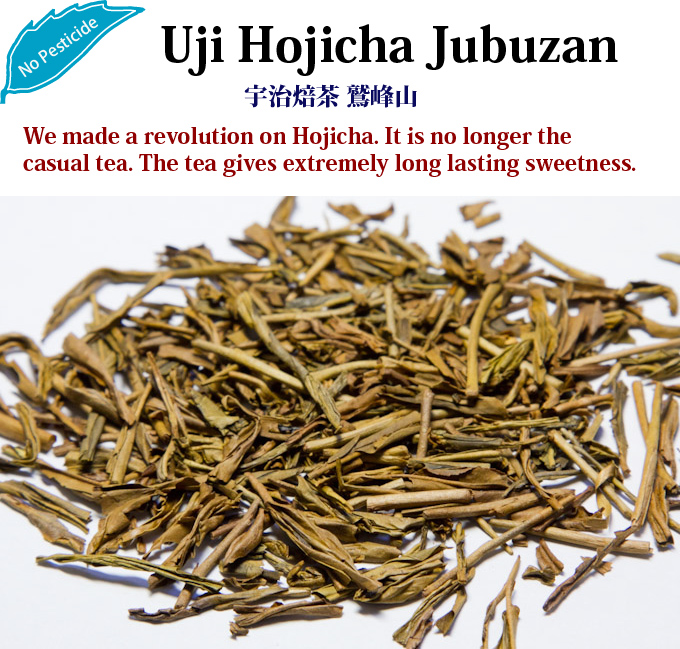
I have always wanted to produce Hoji Cha that the quality is as outstanding as the high grade sencha. So far it was very hard to find the Hoji Cha that gives the deep after taste and very long lasting flavor. To achieve it, I emphasized the quality of raw material. I used Uji Sencha Jubuzan. This tea is produced using natural farming method. Thanks to the outstanding quality of the soil, the tea gives an unusual depth of aftertaste and smooth drinking feeling.
Tea grows very slow without fertilizer and accumulates a lot of polyphenols and minerals. As a result, it gives noticeablly strong aftertaste and thick flavor. If I taste any leaf plucked directly from the tea tree, I can immediately tell its quality because the difference in quality is obvious enough. When I tasted the grown-up leaf of Jubuzan, I was very impressed. It is not the young leaf, yet tea gives a very sweet taste, no bitterness or dryness at all.
For baking this tea, we use sand-roast as it is the most traditional method and always brings out good flavor. Tea gives clear and golden liquor. Most of my customers who tried this tea commented that it doesn't taste like Hoji Cha, but taste like a high-grade oolong tea.
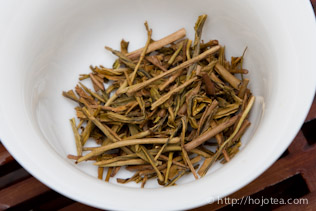 |
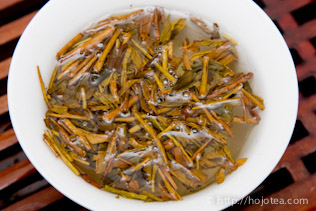 |
The leaf is glossy and amber brown color. From the aroma of dry leaf, you can feel its unusually deep flavor. When you touch, the tealeaf is very tender and elastic.
The quality tea alters the property of water. The higher the quality of the tea, the higher the iron content of the tea. The iron ion changes the strength of hydrogen bond of water and the water's property becomes very close to our body water.
In other word, quality tealeaf modifies the water and make it easier for our body to utilize. Uji Hojicha Jubuzan drastically changes the water property. As a result, we feel relaxed, feel happy and eventually we feel sleepy. This is called "tea drunk" effect.
 |
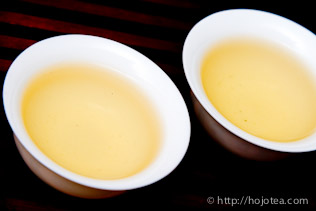 |
The liquor is golden color
This tea is made from Uji Sencha Jubuzan. Unlike most of the ordinary Hoji Cha that is made of stem or late-plucked tea, this Uji Hojicha Jubuzan is made using the high grade tea. The tea that we are selling as Uji Sencha Jubuzan is the material for Uji Hojicha Jubuzan. In addition, the baking process will reduce the moisture, moreover due to the loss by the dust, the production yield of this tea is lower than sencha. Eventually the price of this tea is slightly higher than sencha.
Jubuzan (鷲峰山 682m) is a mountain located between the Wazika (和束町) and Uji Dawara (宇治田原). Once upon a time, these places were the bottom part of the Biwa Lake. Therefore there are very rich in natural red clay.
Traditionally, the logistics of tea in Kyoto was using the river. The river started from Nara or Shigaraki area and flows until Uji area. The upper stream of the river is called Nabari River; Tsukigase and Shigaraki Asamiya is located at this area. When the river flows to downstream, it is named as Kizu River. Kizu River merges with Uji River and once again changes its name to Yodo River. Historically, the tea produced along the Nabari, Kizu and Uji River was called Uji Cha. Even in Japan, most Japanese people mistakenly think that the Uji Cha is from the Uji city. The Uji city is a very well-developed place and very less number of teas exists there. Under the definition, Uji Cha refers to tea produced in the following towns:
We choose tea from the garden which practices natural-farming method. The natural-farming means using no fertilizer and no pesticide. Most of those natural farms do not even remove grasses in order to maintain ecological balance and keep the soil healthy. Most importantly, tea will not be treated with special care, but to take it as one of the wild plants in the environment. The most important thing is not to use the nitrogen-based fertilizer. Nowadays, most of Japanese green teas are grown with excessive application of fertilizer. As a result, tea grows unnaturally fast, tealeaf turns into green color, accumulates excessive amount of amino acid, the size of the cells increases and yet it contains very less polyphenols and minerals.
If you refer to books or web pages, it always explained that theanine is the index for the quality. However, from my point of view, theanine is the index of poor quality. When more fertilizers are applied, the more theanine will be produced by tea. These teas give very light taste and weak after taste. If you directly taste the fresh leaf from the tea tree grown naturally (means the one grown without fertilizer and pesticide) compared to the one grown with plenty of fertilizer, the difference is very obvious. If tea has excessive intake of fertilizer, tea will be actively growing and becomes bigger and bigger. Tea will stop producing the functional substance such as polyphenols. The naturally grown tea has small leaf in yellowish color, and it has less number of leaves. However each tealeaf is very elastic and strong. Most importantly, it needs much longer time for growing. No doubt, the tea is very rich in functional substances and obviously tastes sweet.
The stalks of tea are very noticeable when it is not removed as it is yellow color and lying in the middle of leaves. It is more than the common knowledge that tea merchant will remove the stalks. Once the stalks are removed, tea has very consistent dark green color. It gives a very classic Japanese green tea image.
Nevertheless, we didn't remove the stalks. After series of experiment, we concluded that with the presence of stalks, the taste and the flavor of tea is obviously nicer than the one without stalks. If you have ever tried Karigane, you will know that stalks give sweet flavor. In fact, oolong tea, Chinese green tea or any types of tea in other country, even the exclusive quality also has stalks.
At first, I wonder if the presence of stalks in a teaspoon of tea makes a big difference in terms of taste and flavor. In one teaspoon, there will be only a few to several stalks. In order to verify the effect caused by stalks, I have prepared two samples. First sample is tea that contains stalks. The second sample is the same tea, but I use a forceps to carefully remove all stalks. The result was much more obvious than I have expected. The tea sample with stalks gives a very sweet and flowery flavor, while the tea sample without stalks gives a pungent aroma and lacks sweet flavor. I invited a few sensory panels for the same experiment. They tasted both tea samples, and all of them selected the tea with stalks. From the appearance point of view, the tea leaf looks more beautiful without stalks, but I decided to keep the stalks because the tea tastes much nicer with more appealing flavor.
By the way, Japanese always said that if one could find the stalks of tea standing in your cup of tea, it brings you luck. This indicates that all this while in our tradition, the stalks were not removed from tea. Nowadays I feel Japanese cares too much about the appearance. Although the tea without stalks looks beautiful, to me, it does not make sense if it sacrifices the flavor and taste.
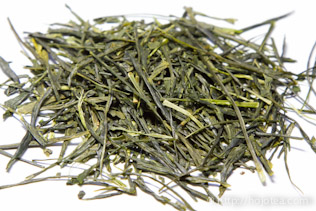
Tea comes from the garden at altitude of 600m. This altitude is exceptionally high in the Uji Cha production region. In winter, the mountain is fully covered by snow. Due to the high altitude, tea receives sufficient sunshine in a daytime, yet the temperature at night is very low. Usually plant grows at night. In a daytime, the plant intakes CO2 and releases oxygen, while at night, the plant intakes oxygen and releases CO2. At high altitude, the low temperature slows down the metabolism rate of tea. Tea stops growing and instead it produces more polyphenols and accumulates minerals. This is the same theory why the taste of vegetable and fruit produced at highland gives better taste and intense flavor.
There is another theory why the tea grown at higher altitude is superior. Originally the Uji area was the bottom part of the Biwa Lake, the biggest lake in Japan. These places where used to be the bottoms of the lake are originally very rich in the fine red clay. That is why the Uji cha region is also known as the hometown of fine clay ware, such as Iga Yaki, Shigaraki Yaki and so on. However as time goes by, the land was slowly washed away by the river. That is how the typical landscape was formed after many years. There are many small mountains surrounded by valleys. Basically the condition of the soil at the valley or on the slope of valley is completely different from the soil at higher altitude. The fine red clay only exists at the peak area, while at lower altitude, there is only white sand. From my point of view, it is very important to choose the specific location of each tea garden. Even if there is naturally grown tea, if the tea garden contains only white sand, the taste of tea will be light.
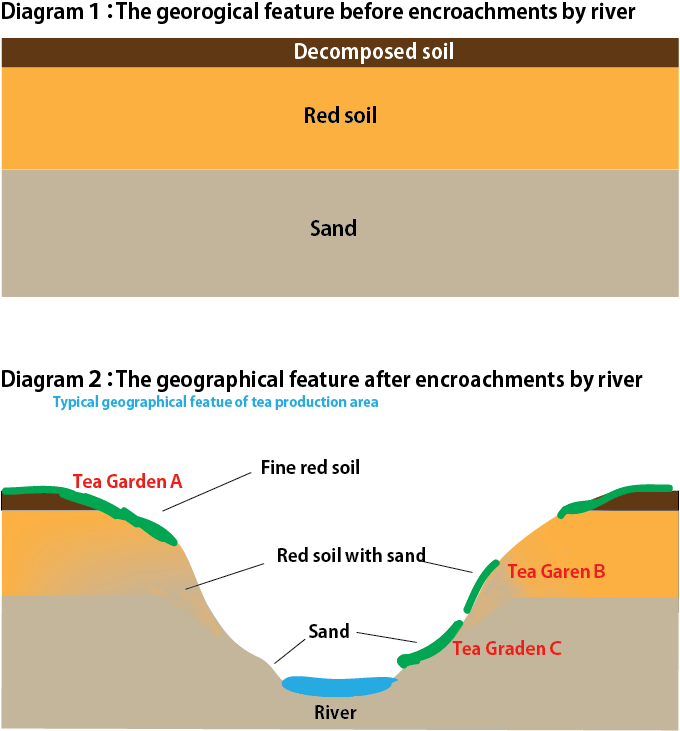

The above photo showed the tea tree that is planted without any fertilizer or pesticide. The entire tea garden was so yellow.
This is exactly the tea garden that I wanted to find in Kyoto as well. If tea has excess amount of fertilizer, it will try to consume the nitrogen and the leaf grows faster and bigger. Actually, even if human does nothing, any plant has an ability to grow, to produce flower and seed naturally. If the plant lacks the nutrition, the plant stops growing, produces small cells with a lot of polyphenol. The polyphenols are the functional substances for plant. The yellow color is the health index of the tea.
The following photo shows the natural plant in summer. As you can see, it is yellow in color. I do believe that this is the natural color.
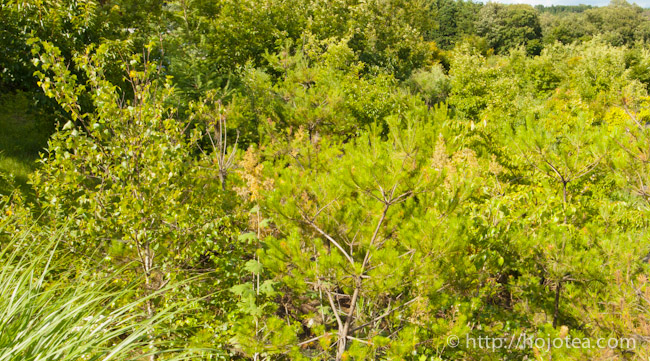
Uji Sencha Jubuzan is produced from the garden that practices natural-farming. Please look at the following photo.
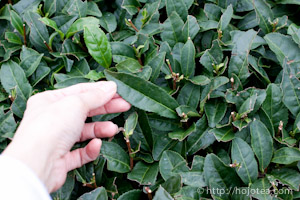 |
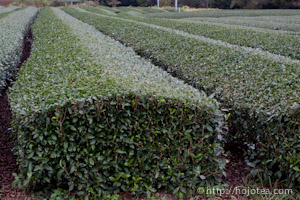 |

The first two photos show the typical garden often seen in Shizuoka. These teas are grown with a lot fertilizer and deep trimming. The leaf is very big, dark green in color and inconsistent in size. The third photo shows the garden that practices the natural-farming. Leaf is very small, yet it looks strong. I plucked and chewed the fresh leaf, even the grown-up leaf is not bitter at all,
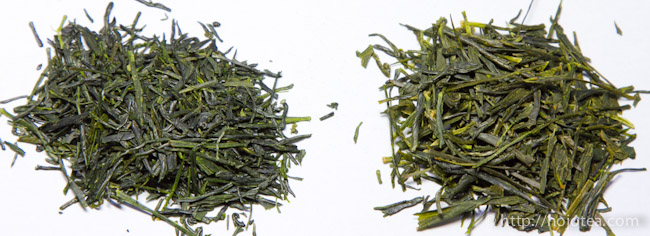
Please look at the above photo. Don't you think the tea on the left is of better quality? It is dark green in color, more consistent and beautiful in shape. The tea on the right is so yellowish. Most of people would think that this tea is either late-plucked tea or oxidized tea. For me, good tea must be yellowish. This leaf shows how it is grown: this yellow color indicates that tea was not applied with excessive fertilizer. Needless to say, the taste and the flavor of the tea on the right is excellent; it reminds me of the taste of wild herbs.
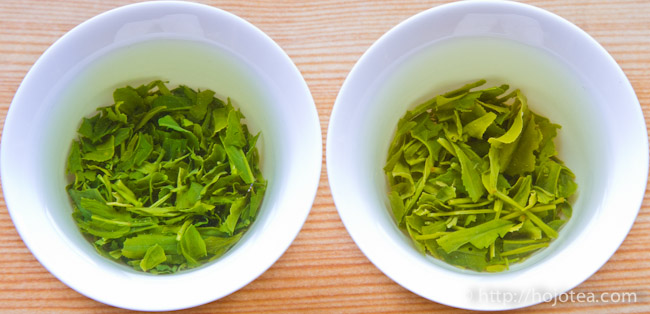
The tea on the left is the ordinary Japanese green tea. In Japan, this is believed to be the good quality tea. The tea on the right is Uji Cha Jubuzan. The yellow leaf is the evidence that this tea was naturally grown.
Many people believe that organic product is good for health and tastier. It is certainly safer since no chemical pesticide is applied. However the organic production has nothing to do with the better taste and providing additional benefit for our health. If the plant grows faster, the taste becomes thinner. If we wish to make tea with excellent tastes, we need tea to grow slower, just like wild herbs in nature. This is the basic logic.
Even in organic farming, animal manures are so rich in nitrogen and it makes plant grows faster. Consequently the taste of tea becomes thin and light. My experience came from Yunnan as I always visit minority people who produce pu-erh tea.
Many of them practice organic production. Basically they do not apply any chemical fertilizer since most of them have no budget to purchase fertilizer, moreover no transport. They often apply animal manures to the older tree because for them, the old tree is very precious. As a result, the taste of tea becomes very thin. The organic fertilizer sounds great but it is also one of the nitrogen sources. It makes plant grows faster and eventually the taste of tea is not as good.
My parent grows apple. They strictly control the application of the fertilizer. If the fertilizer is applied before harvest, the apple grows bigger. On the contrary, the taste becomes very thin and watery. Some farmers who never directly deal with the end-consumer will do it since they just need to ship their apples to the agricultural association, the taste of apple is not very important as long as the appearance looks great. If my parent did the same, they will immediately loss their long-supporting customers. I believe this is a common phenomenon in the Japanese tea market. Most of them sell tea to either Agricultural Association or tea wholesalers. They always emphasize on the appearance, beautiful shape and "green color".
If the plant is busy in growing, it will not produce the functional substance such as polyphenols. The plant keeps on producing cellulose and other carbohydrate in order to support its fast growing rate. These plants are not only light and thin in taste, but also will not have a good effect on our health.
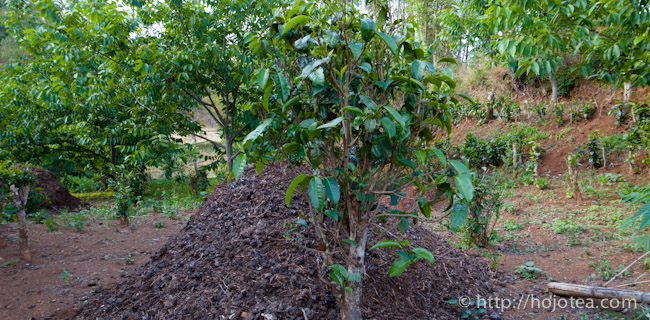
The fertilizer is applied right next to the tea tree. The leaf grows to big size and leaf is also darker green. Regardless of natural or chemical fertilizer, the excessive intakes of fertilizer will make tea very light in taste and weak in aftertaste.
Usually tea tree is trimmed in autumn. In Japan, the common practice is to cut the branches at the lower position of the tea tree. The branches left on the tree are thick like straw. The stout branches will effectively transfer nutrition from the ground. With this method, tea leaf grows faster and the production quantity will be increased. As a result, the aftertaste of tea becomes very shallow. Due to the excessive supply of nutrients, tea will synthesize and accumulate a lot of amino acid. This is the reason that most of Japanese teas give very flat aftertaste as it contains large amount of amino acid. In Japan, people always said that good tea contains more amino acid. Of course it is not true. Good quality tea should contains more minerals and polyphenols but less amount of amino acid.
For making Uji Sencha Jubuzan, only the tip is trimmed to a very minor extent. With this practice, the branch becomes very slim, like a tooth pick. Besides, the size of branches becomes very consistent, the leaves become very small and consistent in size, and the moisture content is distributed evenly. The leaf managed with this method looks yellowish green in color. It is very strong when I touch it. According to farmer, with this production method, tea leaf becomes less effective in absorbtion of nutrients. As a result, it grows very slow and accumulates a lot of substances. This is one of the primary reasons that Uji Sencha Jubuzan is good in quality. Once tea tree is pruned, it produces leaves at very fast growing speed.
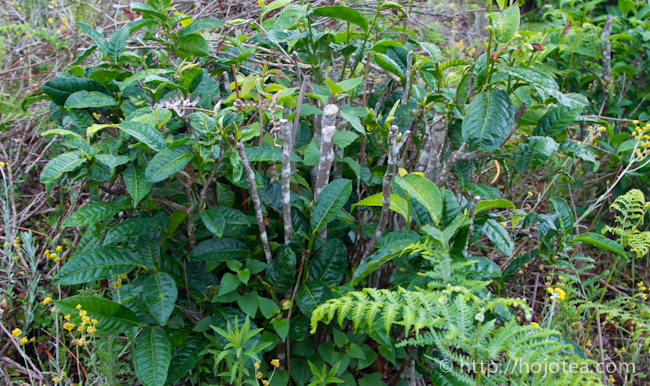
For Uji Hojicha Jubuzan, you do not have to worry. This tea will make you feel rather sleepy.
Uji Sencha Jubuzan contains very high minerals, especially iron. Tea with high mineral content drastically increases blood circulation. As a result, you feel warm and your face blushes. In our body mechanism, we feel relax and sleepy if our blood circulates better. It is the same as having acupuncture, massage or exercise. No doubt this tea contains caffeine as well. However, the effect of caffeine will be overwritten by the effect of minerals. Tea that makes you sleepless is the common tea that has very less minerals. Another benefit of improving blood circulation is we can have deeper sleep, it also ease constipation problem and of course we feel less stressful. If you drink Uji Hojicha Jubuzan more than a few hundreds ml, you may feel a little drunk. The feeling is just like you drink quality wine or whisky.
Well, believe it or not, please give it a try.
Uji Hojicha Jubuzan is produced from Zairai cultivar. In Japanese language, Zairai means "native". As tea is not the native plant of Japan, we regard Zairai as the original cultivator that remains the character of China bush. As Zairai is the direct descendant of wild tea, it has very long roots under the ground and it effectively absorbs minerals. If both Zairai cultivar and ordinary modern cultivar, such as Yabukita, are produced under the same condition, definitely Zairai cultivar is of better quality. Zairai cultivar was planted by the seedling and it undergone complex natural hybridization. In a way, there are various kinds of genetic trait among Zairai cultivars. If we carefully look at the tea trees, each tree is different in terms of the shape of leaf, size and color. If you visit the tea garden that produces exclusive tea in China, you will notice the same situation. In China, these teas are called mixed cultivar. For example, Long Jing: the commercial quality is made of Long Jing No. 43, while the high-end quality is made of mixed cultivar. This term refers to the tea that carries original feature of wild tea.
In you are using tap water, it is necessary to filter the water using an activated carbon filter. If not, you wouldn’t be able to enjoy the authentic taste of tea. Chlorine is added to tap water in order to sanitize bacteria. This chlorinated water will also harm our body cells. Concerning about our health condition, it is very important to remove chlorine from drinking water. The most effective method in removing chlorine is to install an activated carbon filter. This type of filter is designed for removing organic substance. It will remove not only chlorine, but also other harmful substance such as contaminated pesticide. The activated carbon filter can be easily obtained from the common hardware shop in most countries. If activated carbon filter is not available, please place a charcoal inside the water and leave it for over night. The material composed of activated carbon filter is made of ground charcoal. The difference is that activated carbon filter contains much finer particles and hence it has extremely large surface area for a better efficiency in filtration. We do not suggest RO water (reversed osmosis water) or distilled water. This water carries no mineral, the taste and flavor of tea tends to be very unstable, unless you have very superior quality tea and tea equipment.
In the long run, you may observe a thick layer of scale accumulated inside your kettle. Our mother usually taught us to wash and remove it with citric acid. But please do not even try to remove the scale. Scale consists of minerals that exist in the water. The mineral composition is reflected from the water you used. If you remove the scale, the mineral ion balance between scale and water is destroyed. This balance is called buffer effect in science. The flavor and taste will seriously run out and you won’t be able to get previous taste and flavor for a long time. It is also important to stick to the same type of water whenever brewing tea. If source of water is changed, it carries different type of minerals. It will affect the mineral ion balance too.
Go to further information about suitable water for brewing tea >>
The quantity of tea leaf can be calculated by a formula that "Divide the Volume of Water by 5". For example: the volume of teapot = 200ml; 200ml/50 =4g. You need to measure 4g of tea leaves for 200ml of water. As opposite to the traditional brewing method, the modern style uses more volume of water. A teapot with the size about 150-220ml is just nice for one person.
Use boiling water.
The first brewing period is 20-30 seconds.The second brewing must be less than a few seconds. Use the same parameter for the third brewing onwards.
Clay teapot and Tetsubin makes the taste of Sencha even better. It is mainly because of the iron that is released from the equipment. In particular, the iron enhances the depth of after taste.
Most of Green Teas can be brewed in cold water. The higher the grade of tea, the more suitable it is with cold water brewing.
1. Measure 1 table spoons of tea leaves for 500ml of water.
2. Pour the water into a glass jar or bottle and leave it for more than 1 hour.. It is also a good idea to put the tea leaves directly into a PET bottle.
3. Gently sway the container in order to get an even concentration.
4. Usually the taste of tea gets thicker when it is brewed for more than a few hours. In this case, pour in additional water. Eventually tea can be brewed more than 1 liter per 1 table spoon of tea leaves.
1. Measure 4-6g of tea leaves for 200ml of water.
2. Pour water into a clay teapot and brew for 3 minutes.
3. For second brewing, brew for 20 seconds. Alternatively you can also switch to hot water from second brewing onwards, if you wish. If using hot water for second brewing, pour boiling water and brew for less than a few seconds. Since tea leaves are very cold and wet, the temperature drastically drops to less than 60 degree Celsius.
The benefit of cold water brewing is tea can last for a whole day and the taste is refreshing with a natural sweetness. Thanks to the cold water extraction, the level of caffeine in tea is very low. You would not suffer from sleepless nights. Even kids can enjoy this tea.
Once a bag of tea is opened, please finish it within 3 months if you wish to enjoy its freshness. From the medical point of view, it is safe to consume the tea even if it is kept for a few years. However the freshness disappears if it is kept for too long. Tea must be tightly sealed before it is kept. Tea should be kept in ambient and dry conditions such as in the living room, but it must be completely away from humidity. Tea should not be kept in the kitchen as the environment is very humid. Avoid enclosed area such as inside the cupboard or drawer as these places are damp. Also avoid opening the bag of tea in humid atmosphere. It is recommended to open the bag during a sunny day or under air-conditioned atmosphere. Once tea leaves absorb moisture, deterioration of tea will be triggered within a few days. Tea will then give an astringent taste, sometime it tastes sour. The fresh aroma also becomes weaker.
The quality of tea lasts longer if it is kept in the fridge. However we strongly recommend you not to keep tea in the fridge. When tea is withdrawn from the fridge, there is usually condensation. Once tea is exposed to moisture during condensation, the quality will deteriorate within a few days. The higher moisture content in the tea leaves will trigger oxidation and it will completely destroy the quality of tea.
Here’s one frequently asked question: what happens if bag is sealed using tape or tea is packed in zipper bag and kept inside the fridge?
For your information, these simple sealing methods are not sufficient. When the bag is withdrawn from the fridge, it is cold inside the bag and therefore causes negative pressure. Air will be drawn from outside and condensation will occur. In addition, if the bag is taken in and out from the fridge very often, this will cause heat stress to the tea leaves as temperature is increased and decreased very frequently. If tea is kept in the fridge, when it is withdrawn from the fridge, it is necessary to leave it in ambient atmosphere for more than 24 hours in order to warm up the tea leaves. Based on our experience, 12 hours is not long enough. We may think tea is warmed up, but inside the bag, the tea leaves are still cold due to insulation effect.

Please feel free to send us e-mail for enquiry at:

 |
We accept various kinds of credit card through Paypal.
Only if customer prefer other option of payment, we suggest "Bank Transfer".
Various choice of shipping method
EMS, SAL, Small Packet, Small Packet (SAL) Yamato Express and Surface
For shipping tea, we usually suggest small air parcel, the estimated shipping cost of tea in 100g (with wrapping material ) is
Small Parcel
USA JPY 600, EU JPY600 and Asia JPY470
Small Packet (SAL)
USA JPY380, EU JPY380 and Asia JPY320
The shipping fee to oversea by small air parcel happens to be even cheaper than domestic shipping fee in Japan.
For your information, some countries, EU in particular imposes custom duty. We need buyer to bare the duty. We are sorry, but we cannot change the amount on the invoice, and we do not mark any packages as gifts. We will strictly follow the custom regulation.